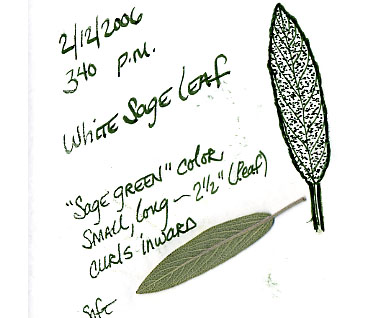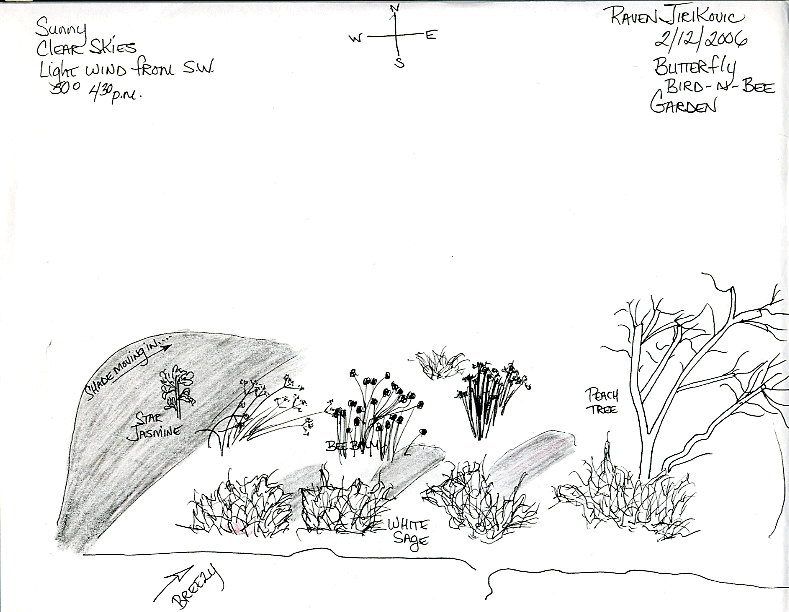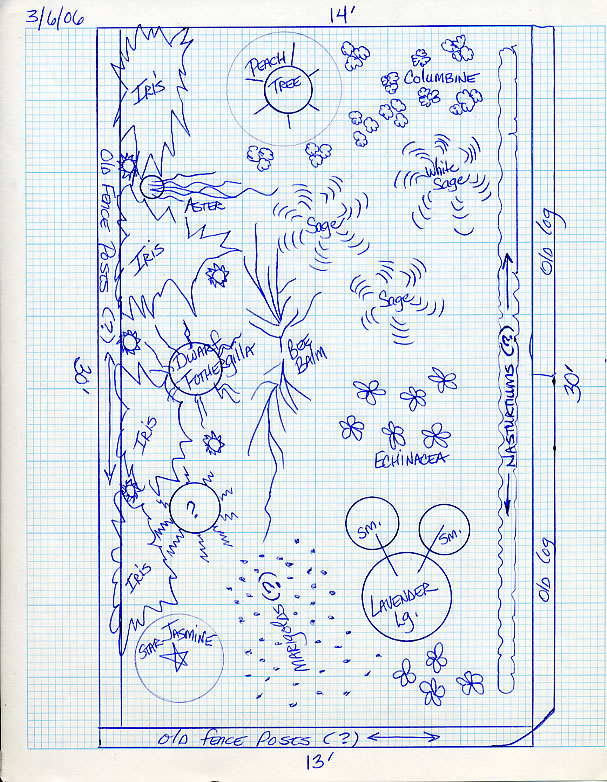This is my garden site. It is a partially established Butterfly-n-Bee garden bed ...a pollinator's delight!
Site dimensions : Length 30' and ends 14' (east end) and 10' (west end). The shape is rectangular. The topography is flat and the bed has an approximate slope of 2 degrees. This bed is oriented to the East and the solar exposure is variable - approximately 7 hours of sun per day, with the west end becoming shaded first. The soil characteristics are 90% organic material and the texture is fine to coarse. The soil color is dark brown and the consistency is light and porous to 12", then compacted hard pan - drainage is good.
The soil on the site is covered with 60% vegetation, and this vegetation is healthy and mature in its stage of growth. The principal plant species present are: Star Jasmine, White Sage, Bee Balm (Monarda), Frost Peach Tree, Borage (Boragago officinalis), Wild Iris/Western Blue Iris (Iris missouriensis), Dwarf fothergilla (Fothergilla gardenii), Red Deadnettle (Lamium spp.) and Hairy Bitter Cress (Cardamine hirsuta).
Evidence of animal activity are rabbit browse and the remnants of a peach pit from the squirrels.
This site was originally created by my partner on his property. The site and property are located on the south end of Whidbey Island. The intent was (and still is) to use as many native plant species as possible, and to make the bed user friendly for wildlife, especially beneficial pollinators. The bed is man-made with all organic matter, consisting of commercially produced compost and wood chips, and compost from our own bins on the property. The White Sage comes from my previous property in Yelm, which brings a sacredness to this site for us. This garden bed is special due to it's location, which is an entry point to our home. The bed is beautiful, but has not yet reached it's full potential. I love the idea of bringing the winged ones close to our entry place...they are the carriers of hope for renewed and continued life.
Below is a recently sketched map of my site and some drawings, followed by some photos recently taken - I was even able to capture some shots during our recent snow on February 12th, 2006.



February 22, 2006
I've been sitting with and looking at my garden site quite a bit. I am trying to remember how it looks each season: What plants have returned and which ones have vanished...and why(?) I talk to this garden (and to my partner) about our collective visions. The answers are slow to come, but there is a feeling for sure. We feel the garden needs some balancing of height and continued color during the winter months. There are also many bare spots that are excited to birth new plants of color and smell to intice the winged ones. I am thinking right now about height, size, color and those plants best suited to the environment (*native plants would be ideal) - in addition to benefitting the butterflys, birds and bees...and cost.
The plants I have in mind are: Lavandula spp. - Lavendar; *Aquilegia formosa - Western Columbine; Echinacea purpurea - Purple Coneflower; *Dodecatheon - Shooting Star; Tagetes - Marigold; Asteraceae (Compositae) - Aster; C. atrosanguineus - Chocolate Cosmos; Impatiens spp. - Impatiens; Helianthus annuus - Common Sunflower; Petunia spp. - Petunias; Penstemen spp. - Penstemen; Pelargonium spp. - Geranium; Begoina spp. - Begonia; Tropaeolum majus - Garden Nasturtium; Dicentra - Bleeding Heart; *Lewisia; Achillea millefolium - Common Yarrow.
March 1st, 2006
Garden Design & Plan
- Specific plant species to be incorporated into existing garden bed:
Latin name - Lavandula spp.
Common name - Lavender
Family - Lamiaceae - Mint family
Growth habit – Shrub
Duration – Perennial
U.S. Nativity – Introduced
Lavender needs full sun and a well drained, loose and slightly alkaline soil. Lavender also benefits from good air circulation. There are many varieties of Lavender and therefore the size can vary significantly. Some have a height of only six inches or so, and other varieties grow to more than four feet in height and quite bushy.
Compost will get the plant off to a good start, with regular watering as needed. Once established, little care is required however, pruning is recommended to stimulate new growth each spring.
Scent and flower color vary. The blooms range from lavender- hued gray to a vibrant royal purple. The flowers are small and grow up spike-like stems. Foliage typically ranges from dusty green to silvery gray. Active growth - spring and summer.
I’m on the lookout for a mid-size starter plant, with vibrant purple flowers that the bees and butterflies will enjoy as well as for aesthetic and culinary purposes (tea, syrup, cookies). One or two Lavender plants will go into this garden design.
Latin name - Echinacea angustifolio
Common name – Echinacea or Purple Coneflower
Family – Asteraceae
Growth habit – Herb
Duration – Perennial
U.S. Nativity – Native
Echinacea prefers full sun or light shade in hotter climates. This plant does best when planted in moist, well-drained soil, however is can also grow in fairly poor and dry soil.
The plant produces large, fragrant pink flowers beginning in April or May. Flower stalk height ranges from three to five feet.
Because these flowers can stand alone nicely and also rise up to match the bushier plants in the garden, I think they will make a good addition to the overall look of this particular garden. Butterflies will enjoy these flowers and I might choose to cut a few for indoor use since they are long lasting and cutting promotes an extended blooming season. Once established well, I’d really like to learn to use the root for immune system stimulant.
I’ll try to start some plants from both seeds and starter plants from the local nursery, using compost and regular watering.
Latin name – Helianthus annuus
Common name – Common Sunflower
Family –Growth habit – Herb
Duration – Annual
U.S. Nativity – Native
Sunflowers enjoy full sun and grow from seed in moist, well-drained soil however; this plant is adaptable and can also do well in fairly poor and dry soil.
The active growth period is summer and growth rate is rapid. The plant produces a single crown with conspicuous seeds. The flowers vary in color from yellow to reddish-brown. Height also varies tremendously, ranging from approximately four feet to ten feet tall. The stalk and leaves are green.
Butterflies like Sunflowers and Birds (and squirrels) enjoy the seeds produced by this plant and I appreciate the strength and boldness of each stalk as it rises above the other plants in the garden. I am looking for a sunflower that will grow four – five feet tall that has some maroon or reddish-brown colors to play off the lower Echinacea plant’s color. This color feels warming as one approaches the doorway to our home.
Latin name – Aquilegia formosa
Common name – Western Columbine
Family – Ranunculaceae
Growth habit - Herb
Duration – Perennial
U.S. Nativity – Native
Columbines prefer light shade and moist, medium to coarse textured soil however, they can tolerate full sun, provided they receive enough moisture. Columbines adapt to a wide variety of conditions and are therefore easy to grow.
Flowers come in a variety of colors, including black and white. The foliage is light green and delicate. Plants grow one to three feet tall and growth rate is rapid. Blooming generally begins in early to mid-May and will often continue through June if the flowers are removed as they age.
I’ll choose some seeds as well as established plants from the nursery, planting them near the borders of our garden. I’m looking for some subtle colors that will look beautiful in front of the Sage. Columbines are a favorite flower of Hummingbirds.
- Design with intended location for species:

- Sequence of activities based on the season:
- March – Prune Peach tree; pull weeds from garden and add top soil mixed with compost; possibly bring in fence posts for borders…to help prevent grass encroachment. Learn more about which varieties I’d like to plant by visiting local nurseries. Photograph.
- April – Dig up the White Sage and possibly other plants to re-design. Weed again as necessary. Purchase seeds and starter plants. Plant starter plants. Photograph.
- May – Weed as necessary. Sow seeds (?). Cover bed with mulch, and water. Cut Echinacea flowers to bring indoors and promote further growth. Photograph.
- June – Weeding and watering as needed. Remove Columbine flowers as they fade to promote continued growth. Possible harvesting of Lavender for culinary use depending on variety planted. Photograph.
- July – Weeding and watering as needed. Possible harvesting of Lavender for culinary use depending on variety planted. Stake Sunflowers if needed.
- August – Regular weekly watering. Photograph.
- September - Regular weekly watering.
- October – Weeding as needed. Trim back old foliage and compost.
- November – February – Allow time for rest and dreams.
- Materials and tools needed:
- Pruning shears, soil, compost, fence posts or rocks (?), mulch, shovel, trowel, gardening gloves, rake, starter plants, seeds, planting instructions, soaker hose, hose.
- Compost system:
- Large compost bin for most weeds and trimmings.
- Watering system:
- Short hose leading to series of soaker hoses weaving throughout the bed.